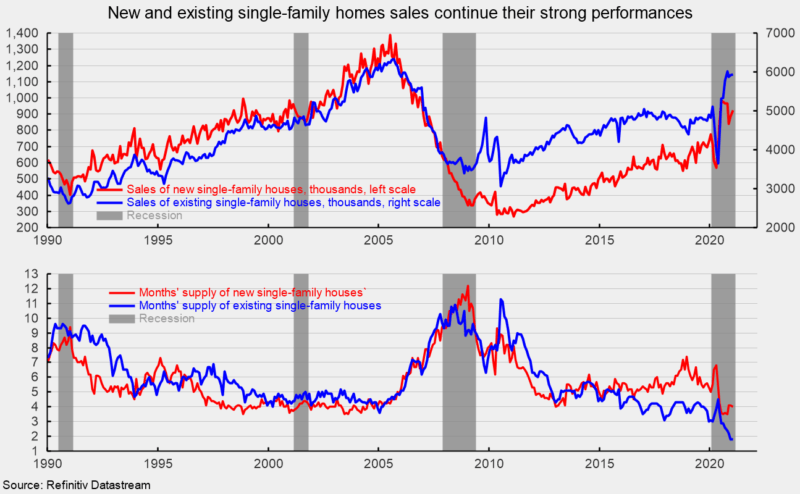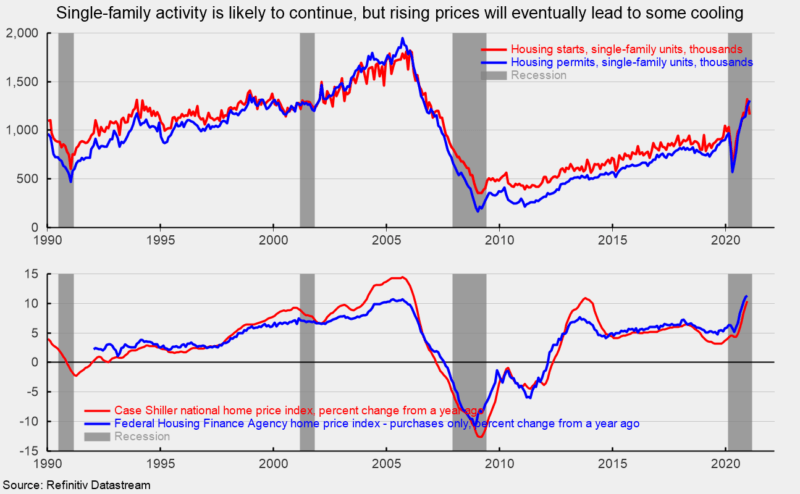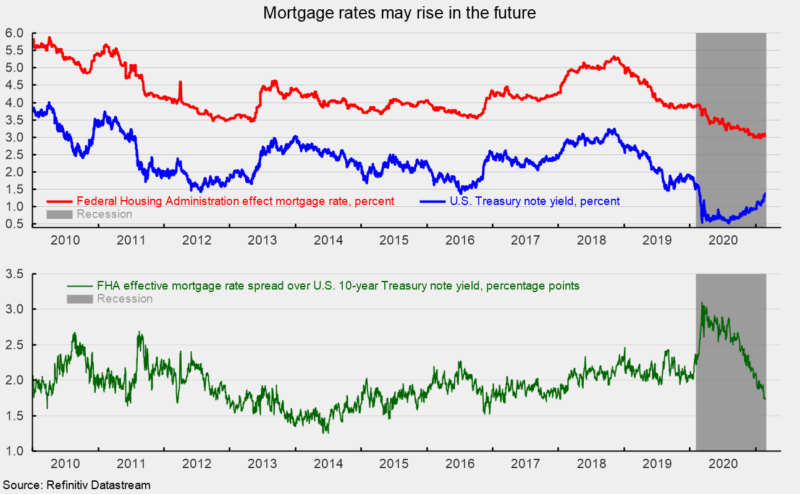Housing Surge Continues as New Single-Family Home Sales Rise Again in January
Sales of new single-family homes rose for a second consecutive month in January, rising 4.3 percent to 923,000 at a seasonally-adjusted annual rate after gaining 5.5 percent in December. Sales are still 5.7 percent below the July peak but are up 19.3 percent from a year ago and are at the fifth highest level since 2006 (see top of first chart).
Sales in the market for existing single-family homes, which account for around 90 percent of total existing-home sales, rose 0.2 percent in January following a 0.7 percent rise in December, coming in at a 5.93 million seasonally-adjusted annual rate. From a year ago, sales are up 23.0 percent and are running at the second-fastest pace since 2006 (see top of first chart).
Total inventory of new single-family homes for sale rose to 307,000 in January, a gain of 2.7 percent, leaving the months’ supply (inventory times 12 divided by the annual selling rate) at 4.0, down 2.4 percent from December and 20.0 percent below the year-ago level (see bottom of first chart). Along with the drop in the months’ supply, the median time on the market for a new home declined to 2.9 months from 3.7 in December.
Total inventory of existing single-family homes was unchanged in January, coming in at 880,000, the lowest on record since tracking began in the mid-1980s. The months’ supply was also unchanged, coming in at 1.8, also a new record low (see bottom of first chart).
Housing permits, considered a leading indicator for future construction activity and the broader economy, surged to a 15-year high in January. Single-family permits were up 3.8 percent at 1.269 million, the highest since August 2006 (see top of second chart). Though single-family housing starts did decline in January, the strong showing for permits and sales suggest starts will likely pick up in coming months.
The National Association of Home Builders’ Housing Market Index, a measure of homebuilder sentiment, rose slightly in February. The gain reflects strong demand for housing but is offset by surging materials costs, especially lumber, and concern over regulatory issues. Overall sentiment remains relatively high.
The Housing Market Index rose to 84 in February, up from 83 in January. The three components of the index had mixed results in the latest month but generally remained at favorable levels. The current single-family sales index was unchanged at 90, the expected single-family sales index fell to 80 from 83 in the prior month, and the traffic of prospective buyers index rose to 72 from 68.
Potential headwinds for the housing market include rising mortgage rates and rising home prices. Home-price measures from Case Shiller and the Federal Housing Finance Agency both show home prices rising at a rapid pace. The Case Shiller index is up 10.4 percent from a year ago while the Federal Housing Finance Agency index is up 11.4 percent. The Case Shiller measure is the fastest gain since December 2013 while the FHFA measure is the fastest on record back to 1992 (see bottom of second chart).
So far, mortgage rates have only drifted up slightly, though 10-year treasury yields have increased noticeably since the lows in the third quarter (see top of third chart). The faster rise by Treasury notes has pushed the spread to the lowest level since 2017 (see bottom of third chart). That could mean higher mortgage rates in the near future.
Overall, single-family housing activity has recovered sharply since the April low as lockdown restrictions that impacted both construction and sales were eased. Furthermore, while mortgage rates remain low for now, providing support for the housing recovery, rising prices and potentially higher mortgage rates in the future may become headwinds for affordability and financing.
Housing is one of the areas that may be experiencing structural change. There appears to be sustained marginal demand for less dense suburban and rural housing as urban dwellers seek alternative housing. This trend could be boosted if businesses implement permanent work from home policies, to make employees happy but also to cut down on high-cost commercial real estate, especially in high-density, high-cost cities. Only time will tell if these conditions continue, but for now the housing market remains one of the brightest areas of the economy.








